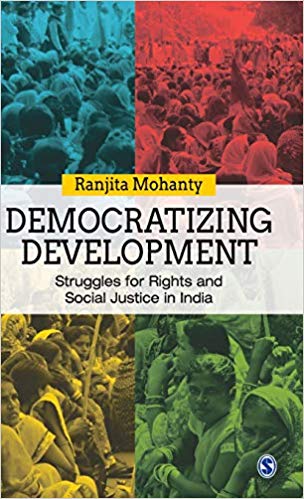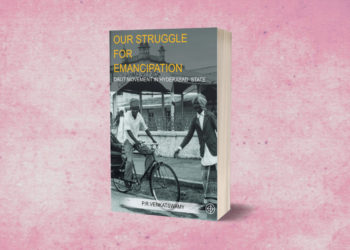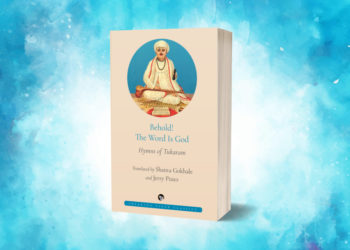Written by Ranjita Mohanty, Democratizing Development: Struggles for Rights and Social Justice in India explores and analyses how development gets vitiated by multiple powers and subverts the democratic ideals of participation, equality, inclusion, redistribution and equity, and how the poor and socially marginalised struggle to make development democratic. Examining development through the lens of the most marginalised, the book shows the democratic potential of development as well as the result of its absence.
The following are excerpts from the chapter “The Kol Resistance: Tribal Mobilization for Land Rights” of the book.

The Kols were the inhabitants of forests from where they were gradually driven out as forests came under state control during the colonial period. The process of displacement continued after the Independence as the state increasingly brought forests under its management. The Kols were further displaced due to industrialization when dams, wildlife sanctuaries and factories encroached upon their land. The Ranipur Sanctuary, the Continental Glass Factory and the Uttar Pradesh Industrial Corporation acquired their land, displacing them from their habitat and livelihood (Joshi 2003; Singh 1993).
Kols, despite being tribal, are categorized as SC in Uttar Pradesh (whereas they are ST in the adjacent state of Madhya Pradesh). The categorization has implications for them because the developmental benefits in the forms of special grants, as also the special inalienable land rights that STs have that put restriction on transfer of tribal land to non-tribals, are not available to the Kols in Uttar Pradesh.
The region where ABSSS began its work is known as Patha, literally means rocky and barren, which is a severely impoverished part of Bundelkhand. Patha is characterized by entrenched socio-economic inequality. Brahmins and Thakurs, the two upper castes, are in possession of large landholdings and yield considerable social influence. Their connection with the local administration, particularly at the block and district, is well established (Joshi 2003). This had implications, as we will see in the following discussion, for the Kols securing land allotted to them under the land reforms. While the upper castes hold good quality land, the land belonging to Kols are often rocky, non-irrigable and thus remain barren or the yield is meagre. The landed upper castes are referred to as dadu, a pejorative term that connotes the power and influence they yield (Joshi 2003). Dadus have appropriated the land of the Kols through deceit and power, at times on ‘gun points’, by what is euphemistically referred to as ‘muscle power’ (Seabrook 1995, 39). Dadus had not only encroached and controlled land belonging to the Kols but had also kept the Kols in a state of continuous deprivation by keeping them under litigation and bondage.
Dadus controlled the land belonging to the Kols, as the Kols were not conversant with the legalities of land titles. As contractors with the forest department, dadus employed the Kols to cut woods and collect tendu leaves. The wages were paid in kind, that is, 1.25 kilograms of food grains for a day’s labour (Singh 1993). This gave rise to indebtedness among the Kols. Taking advantage of the poverty and illiteracy among the Kols, dadus kept them under bondage; in many cases, an entire family worked as beggar (bonded labour) to dadus. The Kols often took debt from the upper castes both in cash and in food grain. They served as bonded labour until they paid off the debt. If they died, their children inherited the bondage. In some cases, the Kols were turned into bonded labours for small amounts of debt, and, in some cases, they remained in bondage for 20 long years (Joshi 2003). The bonded Kol women were often sexually exploited by their owners (Dogra 2000; Joshi 2003; Rashid 2013).
Dadus subverted the land ceiling act by transferring excess land to their Kol servants, who were unaware of this transfer and subsequent implications. It was only when they were harassed for the recovery of loans that the dadus had taken against their land, that they realized how they were further entrapped in bondage. Not only the landed households retained their land by taking advantage of their alliance with the administration and politicians, the ceiling surplus land allotted to the Kols were mere land titles, called patta, without actual possession. In many cases, the land allotted were of poor quality, rocky and non-irrigable; in some other cases, the allotted land came under dispute as the forest department claimed land to build a wild life sanctuary (Joshi 2003). Dadus encroached upon the good quality land allotted to the Kols through threat and/or deceit. There were instances where the land the Kols had taken on lease from the gram sabha and cultivated for 8–10 years were transferred to locally powerful people. In such cases, while the lease was recorded on revenue records of the panchayat, it was not marked on the map, thus creating a purposeful gap that was taken advantage of.1
It is in this situation that ABSSS intervened to mobilize the Kols in the Mau and Manikpur blocks of Chitrakoot District2 to claim titles and possession of the land they were allotted under the land reforms. When ABSSS surveyed the villages, they found that the land reforms and land distribution were marred with fraud, widespread bondage and indebtedness among the Kols. The Kols thus lived in a state of landlessness, poverty and bondage.
[…]
In 1987, ABSSS formed the Patha Kol Adhikar Manch3 with membership from the Kols. The Manch has since then served as a platform for raising awareness among Kols and nurturing leadership among Kol youth. In the same year, ABSSS organized the Chitrakoot Patha Kol Vikas Vichar Gosthi4 where the district collector of Banda announced that the Kols in Manikpur Block would soon get possession of the land allotted to them. A committee was constituted with 11 lekhpals (accountants), and 100 hectares of land was measured for distribution to the Kols. However, the effort stopped at that. There were pressures on the administration; it was believed that dadus had put pressure to close the process (Singh 1993).
ABSSS’s work among the Kols included not only mobilizing to claim land promised under the land reforms but also freeing them from bondage and ensuring their rehabilitation. ABSSS’s advocacy on bonded labour put pressure on the government, and then labour secretary initiated a study in the Manikpur and Shankargarh blocks of Chitrakoot District. The study found 2,900 bonded labour in Manikpur and 3,300 bonded labour in Shankargarh. Yet, the findings of the report could not force the government to take action (Singh 1993). As a result of continuous advocacy on the issue by ABSSS, a bonded labour rehabilitation committee was constituted by the government. In 1983, a bonded labour rehabilitation office was created. The legalities prescribed that those who kept bonded labourer could just free them by giving them a few goats, buffalo and some cash (Singh 1993). No punishment was given to those who kept the Kols in bondage and practised bonded slavery. ABSSS stepped in to help the Kols get the rehabilitation grant.
[…]
A study (Singh 1993) conducted in August 1993 in Manikpur and Mau revealed the following:
1. Around 1971, in Tokria village, 23 Kol persons were given 200 bighas5 of ceiling surplus land. The land belonged to a member of legislative assembly of Banda. Although patta was given, the actual possession did not take place. The Kols were asked to take land other than the ceiling land allotted to them.
2. Land belonging to those not staying in the village was confiscated and their pattas were cancelled. In Mau tehsil, the Kols were settled in the Kalchiha colony by the government in 1974. In 1988, their pattas were cancelled and the land was put under village common without any information to the Kol families.
3. In Mangawan village, nine Kol persons were allotted 10 bighas of land. However, the actual possession did not take place.
4. In Chherihakhurd village, the land allotted to Kols was encroached upon by dadus.
5. In Nihi village, 135 Kol persons could not get the possession of land even though they were allotted the land patta. Dadus had encroached upon their land and pushed them out of the village.
6. In Gobarhai village, eight Kol persons were allotted land pattas, but the land was under the possession of the upper caste Brahmins.
The aforementioned illustrates the power nexus against which civil society has to struggle, and that this struggle is long and arduous. After years of mobilization by ABSSS and through their own organization, the Kols could not overtly challenge the local dominance. However, even though the results in terms of land possession and rehabilitation were limited, the mobilization was making the Kols aware of their bondage and dispossession. As Rajan Kol of Patha Kol Adhikar Manch said,
Despite very adverse conditions, a growing number of Kol youths are coming forward to challenge this oppressive system, and change their life of exploitation and repression. The struggles of forest, land and water are moving ahead. The results can be seen in the improved living conditions of hundreds of families. (Dogra 2000, 5)
1. Personal communication with Bhagwat Prasad, the director of ABSSS, in 2016.
2. The blocks were part of Banda District at that time.
3. An organization of the Kols living in the Patha region to pursue their rights.
4. Public discussion on the situation of the Kols in Patha region.
5. A measure of land area varying locally from 1/3 to 1acre.




